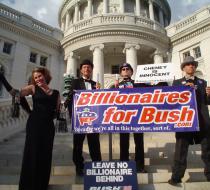Billionaires for Bush Favorite
“Some people call you the elite,” George W. Bush joked to his wealthy funders, “I call you my base.” Whether candidate Bush meant it as a joke or not, the Billionaires for Bush (B4B) campaign used humor, street theater and creative media actions to show the country how true the quip was. Working to expose how the Republican Party serves the interests of the super-rich, the Billionaires also addressed the broader issues of economic inequality and corporate greed.
An early version of the campaign in 2000, “Billionaires for Bush (or Gore),” had spread virally via the internet and mainstream media exposure. It rebranded itself for the 2004 election, taking as its crusade the defeat of Bush. The New York City chapter took the lead, assembling talented volunteers, among them professional designers, media producers, and actors. It then put the campaign pieces in place. A stylish logo swapped the Republican elephant with a piggy bank stuffed with bills. Satirical slogans — “Repeal the First Amendment,” “Free the Forbes 400,” “Corporations are people too” — adorned bumper stickers, buttons, and a slick website, mimicking the look of Bush-Cheney propaganda. A songwriter produced tuneful renditions of what the super-wealthy really think, performed by meticulously rehearsed singers. The members themselves adopted personae, with names and
costumes to match, spoofing iconic versions of the .01 percent: the Monopoly-style robber baron (Phil T. Rich), the dim-witted heiress (Alexis Anna Rolls), the trust-fund fuck-up (Monet Oliver D’Place), and so on.
Soon, the Billionaires could be found talking down to “the little people” at Bush-Cheney campaign events, left-wing rallies, and street corners. They could also be found all over the mainstream media, garnering thousands of hits, including multiple features in the New York Times and on network and cable TV. Even the chant “Watch more Fox News, then you’ll share our right-wing views!” made it to air… on Fox News.
Media coverage was generated by carefully planned hoaxes, such as the appearance, to a throng of adoring billionaires, of a Karl Rove impostor at a GOP fundraiser. Other times, the campaign outsmarted the authorities to attract the media glare, such as when it held a croquet match on Central Park’s “Great Lawn,” from which a half-million anti-Bush demonstrators had been banned by New York’s mayor. The media was smitten by the Billionaires’ glamour and charmed by their say-the-opposite-of-what-you-believe theatrics.
The campaign was designed to be participatory and national. The core idea was easy both to replicate and embellish. Activists could download the materials they needed to do local actions, while a field organizer helped set up chapters in swing states like Ohio. By late July the hundreds of B4B “billionaires” from thirty states who showed up to protest at the Republican National Convention far exceeded the number of actual billionaires working hard for their President.
Deflated by Bush’s victory, the B4B idea nonetheless lived on, generating spin-off campaigns such as Billionaires for Wealthcare, active in the health care debates of 2008-9. Often feeling in 2004 like a clever joke in the wilderness, the campaign in fact anticipated many of the core concerns of Occupy Wall Street and other “Great Recession”-era activism
(Reposted from www.beautifultrouble.org)







